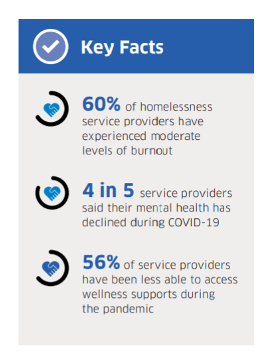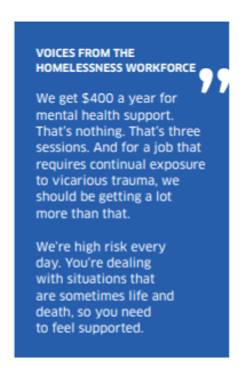COVID-19 has had an overwhelming impact on people experiencing homelessness and precarious housing, as well as community organizations and service support workers providing assistance. The pandemic has highlighted and exacerbated existing gaps in housing policy, long-standing underfunding across the sector, a rapidly worsening overdose crisis, and an insufficient supply of mental health and substance use supports.
Drs. Nick Kerman and Sean Kidd at the Centre for Addiction and Mental Health (CAMH) led a national mixed-methods study to understand the mental health and support needs of service providers who work with people experiencing homelessness in Canada, taking into consideration the impacts of the pandemic. To explore the policy dimensions across these initial findings, the Mental Health Commission of Canada in collaboration with CAMH released a policy brief that calls for action on this important issue.
 Over the past year and a half, non-profit community organizations, service support workers, community workers, and volunteers have been providing essential services to people experiencing homelessness and precarious housing while responding to this unprecedented public health emergency. They are part of an under-recognized, essential workforce that is shouldering much of the burden resulting from the higher risk for COVID-19 among those experiencing homelessness, as well as continuing to support their health and housing needs in communities where services have become more inaccessible.
Over the past year and a half, non-profit community organizations, service support workers, community workers, and volunteers have been providing essential services to people experiencing homelessness and precarious housing while responding to this unprecedented public health emergency. They are part of an under-recognized, essential workforce that is shouldering much of the burden resulting from the higher risk for COVID-19 among those experiencing homelessness, as well as continuing to support their health and housing needs in communities where services have become more inaccessible.
Direct service workers in the homelessness sector have faced fears related to contracting COVID-19, increased stress, and isolation. They are working demanding jobs, with increased health risks, low wages, and limited resources — while witnessing tremendous suffering among some of our most marginalized people. These experiences put service support workers at greater risk of experiencing burnout, vicarious trauma, compassion fatigue, and other mental health and substance use problems.
As well, the homelessness service support sector is made up mainly of women, racialized individuals, other equity-seeking people, and a sizeable proportion of these providers have lived experience of mental health challenges, substance use, and homelessness. These characteristics highlight the greater precarity across the care and social services economy.
As we head into a potentially difficult winter, continue to grapple with the pandemic, and begin planning sustainably for the long-term, now is the time to prioritize funding and resources to support the essential work of direct service providers and organizations in the homeless service sector across Canada.
What can be done at the service sector and organizational level?
- Build the capacity of service providers to respond to their own mental wellness needs and the needs of others through the provision of supervision and ongoing training.
- Strengthen support networks within and across organizations working to address homelessness, including through community support and advocacy, supervisory support, and mutual support among direct service providers.
- Provide opportunities and resources needed by direct service providers to process and grief losses from the overdose crisis and COVID-19 pandemic.
- Expand relief staff rosters so that staff are able to comfortably take time off work when needed.
- Change the designation of “sick days” to “wellness days” to reduce stigma and fears associated with taking personal days for mental health reasons.
What can be done at the policy level?
To effectively prevent COVID-19 while concurrently addressing the mental health needs of homeless service providers and people experiencing homelessness, policymakers should aim to:
- Build on the emergency relief provided to shelters and social service organizations during the pandemic to address funding, resource, and policy gaps at the federal, provincial, and municipal levels.
- Prioritize direct service providers across the homeless service and supportive housing sectors for the provision of resources as the pandemic continues.
- Extend improvements to pay and benefits, including hazard pay and sick leave, as part of broader efforts to change the culture within the homeless service sector.
- Increase access to mental health supports for the homeless service workforce, including through employment-based benefits.
Where can I learn more about this topic?
- Nick Kerman and colleagues’ study of mental health of service providers working with people experiencing homeless during the COVID-19 pandemic (academic article)
- Jeannette Waegemakers Schiff’s Working with Homeless and Vulnerable People: Basic Skills and Practices (book)
- Mimi Choy-Brown and colleagues’ study on clinical supervision in supportive housing (academic article)



